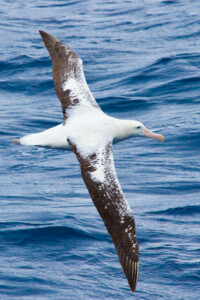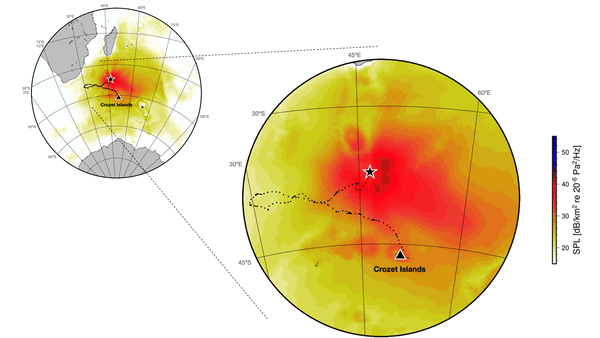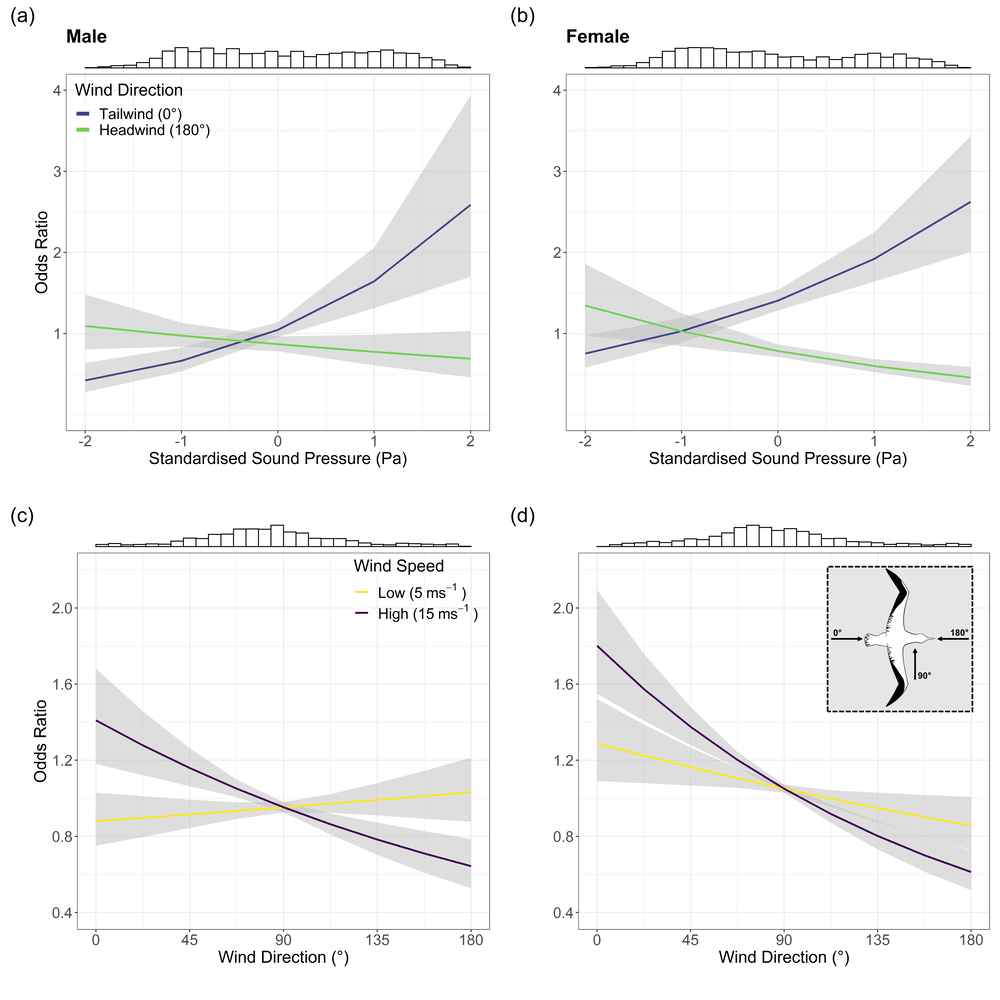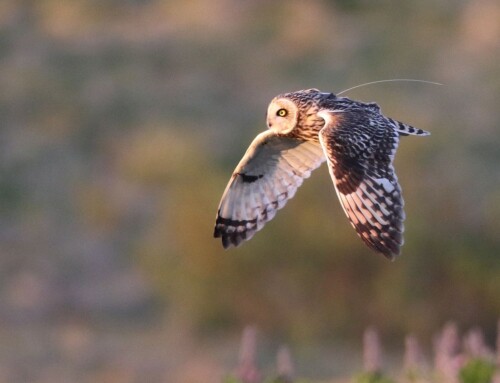LINKED PAPER  Albatross movement suggests sensitivity to infrasound cues at sea. Gillies, N., Martin Lopez, L.M., den Ouden, O.F.C., Assink, J.D., Basille, M., Clay, T., Clusella-Trullas, S., Joo, R., Weimerskirch, H., Zampolli, M., Zeyl, J.N., Patrick, S.C. 2023. Proceedings of the National Academy of Sciences (PNAS). DOI: 10.1073/pnas.2218679120. VIEW
Albatross movement suggests sensitivity to infrasound cues at sea. Gillies, N., Martin Lopez, L.M., den Ouden, O.F.C., Assink, J.D., Basille, M., Clay, T., Clusella-Trullas, S., Joo, R., Weimerskirch, H., Zampolli, M., Zeyl, J.N., Patrick, S.C. 2023. Proceedings of the National Academy of Sciences (PNAS). DOI: 10.1073/pnas.2218679120. VIEW
Finding your way through the vast ocean is a formidable task. Sea-faring animals must traverse an ever-changing environment where visual cues are scarce. As well as charting their course back home or pinpointing locations that might be teeming with food, flying seabirds face the added challenge of grappling with weather conditions, seeking out winds that will carry them along their intended path, while working to avoid those that could lead them astray or spell disaster.
For no seabird is this more challenging than the wandering albatross. With their colossal wingspan, which can easily reach 3.5 meters, albatrosses are at the mercy of the ocean’s ever-shifting weather patterns. Their survival hinges on the ability to identify winds and waves that will lift them into flight and give them sufficient energy to carry them 1000s km across the ocean (Weimerskirch et al. 2012; Richardson 2011). But how do they manage this extraordinary feat?
Imagine this – you step outside and can tell it’s windy right where you are, but can you figure out what the weather is like in the next city over? How about 1000 km away? There is plenty of evidence that albatrosses respond to the immediate wind conditions they experience while flying. But like us, predicting what those conditions will be like further away is a completely different story. For a bird that can cover distances exceeding 10,000 km on a single feeding trip, this is essential. This is where we think infrasound might come in.

Figure 1. We modelled infrasound availability across the foraging range of wandering albatrosses. This figure shows infrasound in relation to an individual bird’s foraging track, with the bird’s home colony indicated by the black triangle, and it’s current position by the black star. Redder areas indicate ‘louder’ infrasound.
Infrasound is very low frequency sound that pervades the marine environment, giving it the colloquial name ‘the voice of the sea’. Across the world’s oceans, infrasound is produced by standing ocean waves, creating a constant hum that is louder where waves crash together with more energy, or where they hit the shore. As a low frequency sound wave, infrasound can propagate over very long distances. By mapping infrasound loudness and propagation, we can produce ‘soundscapes’ of the marine environment. While infrasound is well below human hearing sensitivities, many animals, including elephants and whales, are already known to use it as a form of very long-distance communication. But could it also be informative to animals trying to make long distance journeys?
To work out whether albatrosses might by using infrasound as their secret weather forecasting tool, we looked at birds’ flight trajectories on their long journeys across the sea, and examined how this lined up with maps of the infrasound we think they could hear. Using models of the ocean’s ‘infrasoundscape’, which we had previously verified using infrasound-measuring ‘backpacks’ attached to the birds themselves (den Ouden et al. 2021), we asked whether infrasound in the environment might be influencing the birds’ movement.

Figure 2. Wandering albatrosses responded to both wind and infrasound on their foraging trips. When flying in tailwinds, albatrosses preferentially moved towards areas containing ‘loud’ infrasound (panels (a) and (b)). Instantaneous wind also guided their movements. Albatrosses preferred to move in directions that gave them strong tailwinds (panels (c) and (d)).
As has previously been found (Clay et al., 2020; Weimerskirch et al. 2000), we saw that albatrosses fly primarily with strong tailwinds that help keep them in the air. But beyond that, we were excited to see that they also moved towards ‘loud’ infrasound areas. In other words, albatrosses seemed to be using favourable wind conditions to carry them to ‘loud’ areas of the ocean. Because albatrosses are so dependent on wavy and windy areas to efficiently carry them thousands of kilometres across the ocean, we speculate that they might be using infrasound as an indicator of places where the weather conditions will make movement easier.
This potential use of infrasound hasn’t been overlooked by humans either. Researchers are currently investigating the potential for infrasound to improve the accuracy of weather predictions. So, albatrosses are not just magnificent flyers, they might be nature’s long-range weather forecasters.
For now though, we can say that for the first time, we have evidence that animals might move in response to infrasound cues. And there’s no reason to think this would be unique to albatrosses. Most seabirds move far and wide across the open ocean, and so could benefit of tapping into the whispers of infrasound. Back on land, infrasound’s association with geographical features such as mountains and coastlines, as well as its links to weather phenomena, could make it a vital source of information for long-distance migrants and navigators.
In fact, we aren’t the first to propose that infrasound might help animals to find their way. When the take-off of now-retired supersonic jet Concorde coincided with the disappearance of 60,000 pigeons during a homing race, researchers speculated that the jet’s sonic boom had disrupted their ability to navigate by blocking their access to infrasound cues that they were using to home. Together with our results, there is mounting evidence that infrasound might be an overlooked cue for navigation and movement in a variety of species.
In the complex world of movement, it’s all about having a multi-sensory toolkit, where every bit of information can help individuals to make the right decisions about where and when to move. Our findings hint at the intriguing possibility that hearing plays a role in the grand orchestra of animal movement.
References
Patrick, S.C., Assink, J.D., Basille, M., Clusella-Trullas, S., Clay, T.A., den Ouden, O.F., Joo, R., Zeyl, J.N., Benhamou, S., Christensen-Dalsgaard, J. & Evers, L.G. 2021. Infrasound as a cue for seabird navigation. Frontiers in Ecology & Evolution 9. VIEW
Den Ouden, O.F., Assink, J.D., Oudshoorn, C.D., Filippi, D. & Evers, L.G. 2021. The INFRA-EAR: a low-cost mobile multidisciplinary measurement platform for monitoring geophysical parameters. Atmospheric Measurement Techniques 14. VIEW
Weimerskirch, H., Guionnet, T., Martin, J.S.S.A., Shaffer, S.A. & Costa, D.P. 2000. Fast and fuel efficient? Optimal use of wind by flying albatrosses. Proceedings of the Royal Society of London. Series B: Biological Sciences 267. VIEW
Clay, T.A., Joo, R., Weimerskirch, H., Phillips, R.A., Den Ouden, O., Basille, M., Clusella‐Trullas, S., Assink, J.D. and Patrick, S.C. 2020. Sex-specific effects of wind on the flight decisions of a sexually dimorphic soaring bird. Journal of Animal Ecology 89. VIEW
Richardson, P.L. 2011. How do albatrosses fly around the world without flapping their wings?. Functional Ecology 88. VIEW
Image credit
Top right: A wandering albatross flying across the Southern Ocean © Samantha Patrick.




